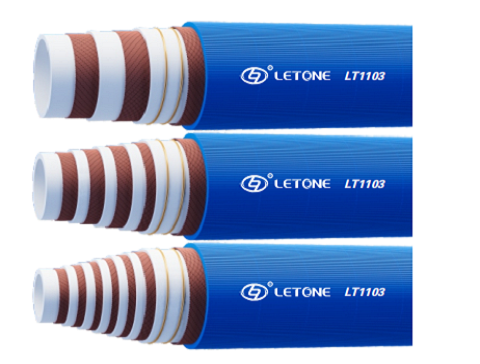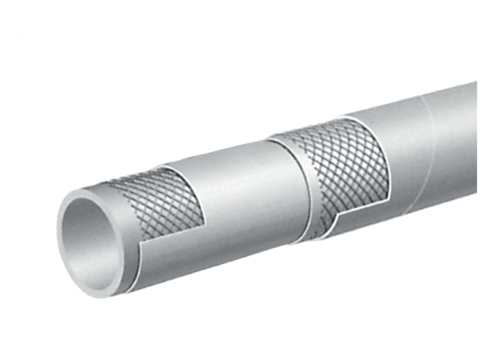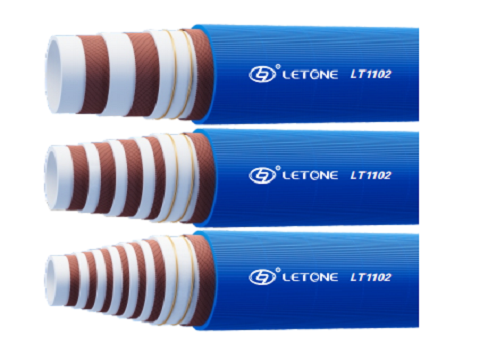In modern industrial processes, steam rubber hoses have become essential for various steam transmission applications due to their excellent temperature resistance and flexibility. As an industrial practitioner or purchaser, understanding the characteristics and application scenarios of steam rubber hoses can not only improve equipment efficiency, but also ensure safe operation. This article will deeply analyze the usage background, material composition, selection points, and maintenance methods of steam rubber hoses.
Background and importance of steam rubber hoses
Steam rubber hose is a connecting device used to transfer steam between industrial equipment. These devices typically involve chemical plants, refineries, food processing plants, and other places that require high-temperature steam transmission. The reason why steam rubber hoses are widely popular is mainly due to their excellent high temperature resistance and flexibility. It can withstand temperatures up to several hundred degrees while maintaining stable elasticity and structural integrity.
 The emergence of this type of hose greatly simplifies the laying of steam pipelines in industrial equipment, making machine maintenance and equipment movement more convenient. In addition, the durability and strength of steam rubber hoses ensure their stable operation in harsh environments, greatly reducing the risk of downtime caused by equipment failure.
Materials and Construction of Steam Rubber Hoses
Steam rubber hoses are mainly composed of synthetic rubber, fabric layers, and metal reinforcements. Specifically, its outer layer is usually made of EPDM (ethylene propylene diene monomer) rubber, which has good heat resistance, oxidation resistance, and chemical corrosion resistance, and can work stably under high temperature and harsh conditions.
The inner layer of the hose is usually made of a special steam resistant rubber to ensure that steam passing through the hose will not cause aging or decomposition inside the hose due to high temperatures. In order to improve the pressure resistance of the hose, many steam rubber hoses will add a synthetic fiber weaving layer or steel wire reinforcement layer between the rubber layers.
This composite structure not only enhances the strength and pressure resistance of the hose, but also improves its resistance to torsion and breakage, making it more suitable for dynamic applications.
Key factors for selecting steam rubber hoses
It is essential to understand the application requirements and relevant parameters of steam rubber hoses in order to purchase the most cost-effective option. Here are several important considerations:
1. Work pressure and temperature
Ensure that the selected hose can withstand the maximum working pressure and temperature in specific applications. Hoses with ratings higher than actual working conditions should always be selected to ensure safety and long-term use.
2. Diameter and length of hose
Select the appropriate hose diameter and length according to the installation requirements of the equipment to ensure sufficient steam flow and the most efficient steam delivery capacity.
3. Chemical resistance of materials
If your application involves any chemicals that may corrode rubber, special attention should be paid to the material's chemical corrosion resistance when selecting.
4. Certification and Standards
Ensure that the hose complies with relevant industry standards and certifications, such as ISO, DIN, etc., which guarantees the reliability of the hose in terms of quality and safety.
5. Brand reputation and after-sales service
Choosing experienced manufacturers or brands can provide better product quality and after-sales service guarantees.
Application scenarios of steam rubber hoses
Steam rubber hoses are widely used in many industries and are commonly used in the following situations:
-Chemical and pharmaceutical industries
These hoses are used for heating and tracing reaction vessels and other containers, as well as transporting high-temperature fluids to facilitate chemical reactions.
-Heating and air conditioning system
In large-scale heating and air conditioning systems, steam rubber hoses are used to transport steam and hot water for heating.
-Shipbuilding and automotive industries
Used for connecting heat tracing pipelines in equipment such as condensers and boilers, as well as cooling vehicle turbochargers.
Maintenance and upkeep of steam rubber hoses
For steam rubber hoses, daily maintenance can significantly extend their service life. Here are some common maintenance methods:
1. Regular inspection
Regularly inspect the appearance and connections of hoses on a weekly or monthly basis, looking for any signs of cracking, wear, or deformation.
2. Cleaning
Regularly wipe the outer layer of the hose with a soft cleaning solution and cloth to remove any chemical residues that may cause corrosion.
3. Avoid extreme environments
Prevent hoses from being exposed to extreme high temperatures or strong ultraviolet radiation for extended periods of time, reducing the rate of material aging.
4. Reasonable use of pressure
Follow the pressure usage guidelines provided by the manufacturer to avoid excessive increase in internal pressure that may cause hose rupture.
5. Replace damaged components
If any part of the hose is found to be damaged, it should be immediately stopped and replaced with a new hose to ensure system safety.
In short, steam rubber hoses play a crucial role in industrial production. By understanding its characteristics, purchasing precautions, and sufficient daily maintenance, enterprises and users can effectively improve production efficiency and ensure safe operation. Maintaining an understanding of product characteristics and application requirements during the selection and use process can help users better choose and use steam rubber hoses, achieving optimal performance and longest lifespan.
The emergence of this type of hose greatly simplifies the laying of steam pipelines in industrial equipment, making machine maintenance and equipment movement more convenient. In addition, the durability and strength of steam rubber hoses ensure their stable operation in harsh environments, greatly reducing the risk of downtime caused by equipment failure.
Materials and Construction of Steam Rubber Hoses
Steam rubber hoses are mainly composed of synthetic rubber, fabric layers, and metal reinforcements. Specifically, its outer layer is usually made of EPDM (ethylene propylene diene monomer) rubber, which has good heat resistance, oxidation resistance, and chemical corrosion resistance, and can work stably under high temperature and harsh conditions.
The inner layer of the hose is usually made of a special steam resistant rubber to ensure that steam passing through the hose will not cause aging or decomposition inside the hose due to high temperatures. In order to improve the pressure resistance of the hose, many steam rubber hoses will add a synthetic fiber weaving layer or steel wire reinforcement layer between the rubber layers.
This composite structure not only enhances the strength and pressure resistance of the hose, but also improves its resistance to torsion and breakage, making it more suitable for dynamic applications.
Key factors for selecting steam rubber hoses
It is essential to understand the application requirements and relevant parameters of steam rubber hoses in order to purchase the most cost-effective option. Here are several important considerations:
1. Work pressure and temperature
Ensure that the selected hose can withstand the maximum working pressure and temperature in specific applications. Hoses with ratings higher than actual working conditions should always be selected to ensure safety and long-term use.
2. Diameter and length of hose
Select the appropriate hose diameter and length according to the installation requirements of the equipment to ensure sufficient steam flow and the most efficient steam delivery capacity.
3. Chemical resistance of materials
If your application involves any chemicals that may corrode rubber, special attention should be paid to the material's chemical corrosion resistance when selecting.
4. Certification and Standards
Ensure that the hose complies with relevant industry standards and certifications, such as ISO, DIN, etc., which guarantees the reliability of the hose in terms of quality and safety.
5. Brand reputation and after-sales service
Choosing experienced manufacturers or brands can provide better product quality and after-sales service guarantees.
Application scenarios of steam rubber hoses
Steam rubber hoses are widely used in many industries and are commonly used in the following situations:
-Chemical and pharmaceutical industries
These hoses are used for heating and tracing reaction vessels and other containers, as well as transporting high-temperature fluids to facilitate chemical reactions.
-Heating and air conditioning system
In large-scale heating and air conditioning systems, steam rubber hoses are used to transport steam and hot water for heating.
-Shipbuilding and automotive industries
Used for connecting heat tracing pipelines in equipment such as condensers and boilers, as well as cooling vehicle turbochargers.
Maintenance and upkeep of steam rubber hoses
For steam rubber hoses, daily maintenance can significantly extend their service life. Here are some common maintenance methods:
1. Regular inspection
Regularly inspect the appearance and connections of hoses on a weekly or monthly basis, looking for any signs of cracking, wear, or deformation.
2. Cleaning
Regularly wipe the outer layer of the hose with a soft cleaning solution and cloth to remove any chemical residues that may cause corrosion.
3. Avoid extreme environments
Prevent hoses from being exposed to extreme high temperatures or strong ultraviolet radiation for extended periods of time, reducing the rate of material aging.
4. Reasonable use of pressure
Follow the pressure usage guidelines provided by the manufacturer to avoid excessive increase in internal pressure that may cause hose rupture.
5. Replace damaged components
If any part of the hose is found to be damaged, it should be immediately stopped and replaced with a new hose to ensure system safety.
In short, steam rubber hoses play a crucial role in industrial production. By understanding its characteristics, purchasing precautions, and sufficient daily maintenance, enterprises and users can effectively improve production efficiency and ensure safe operation. Maintaining an understanding of product characteristics and application requirements during the selection and use process can help users better choose and use steam rubber hoses, achieving optimal performance and longest lifespan.







